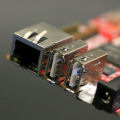A pseudo terminal for the Yocto-Serial
![]() Many home automation projects use mini-PCs running under Linux. Some of these mini-PCs have an HDMI output, but other, such as the OLinuXino, don't have a video output. In this case, the solution to configure these boards is to use a serial console. The problem is that no computer has a serial port anymore and if you have an old enough computer to have an RS232 port, you can't use it because the RS232 port works in 12 Volts. The traditional solution is to use a USB-serial adapter sold by the constructor. But you can also use a Yocto-Serial.
Many home automation projects use mini-PCs running under Linux. Some of these mini-PCs have an HDMI output, but other, such as the OLinuXino, don't have a video output. In this case, the solution to configure these boards is to use a serial console. The problem is that no computer has a serial port anymore and if you have an old enough computer to have an RS232 port, you can't use it because the RS232 port works in 12 Volts. The traditional solution is to use a USB-serial adapter sold by the constructor. But you can also use a Yocto-Serial.
| No comment yet | Read more... |
A $9 CPU to use our modules
![]() As you might have guessed, at Yoctopuce we like to try out new computer and electronic gadgets, and especially so when it's possible to use them with our modules. A few months ago, Kickstarter financed a $9 "computer": C.H.I.P. We backed this project enthusiastically, and last week we received the Alpha version of this mini-PC.
As you might have guessed, at Yoctopuce we like to try out new computer and electronic gadgets, and especially so when it's possible to use them with our modules. A few months ago, Kickstarter financed a $9 "computer": C.H.I.P. We backed this project enthusiastically, and last week we received the Alpha version of this mini-PC.
| 2 comments | Read more... |
The quest for the ideal Mini-PC (second edition)
 Almost two years ago, we wrote a quick review of some available mini PCs. Since then, new machines have appeared on the market. We tested some of them. Some were used to control some of our friday projects, others were bought just for the fun of playing with them. Here are some thoughts about these mini-PCs we tested...
Almost two years ago, we wrote a quick review of some available mini PCs. Since then, new machines have appeared on the market. We tested some of them. Some were used to control some of our friday projects, others were bought just for the fun of playing with them. Here are some thoughts about these mini-PCs we tested...
| One comment | Read more... |
Controlling XBMC with a Yocto-Display
 We showed you previously how to use a Yoctopuce screen to display information coming from Internet, such as an RSS feed or Google Calendar events. Today, we are going to show you how you can use a Yocto-Display to build an active control panel for an XBMC media center.
We showed you previously how to use a Yoctopuce screen to display information coming from Internet, such as an RSS feed or Google Calendar events. Today, we are going to show you how you can use a Yocto-Display to build an active control panel for an XBMC media center.
| 2 comments | Read more... |
Installing the VirtualHub on a QNAP NAS
 Until now, it was possible to run the VirtualHub on a QNAP NAS, but only for the NAS servers using an ARM processor. Moreover, we didn't have a .qpkg file to make installation easier. We are putting this straight by providing you with a QNAP package to easily install the VirtualHub from the NAS web interface. This enables you to easily monitor the temperature of the room hosting your NAS using a simple Yocto-Temperature.
Until now, it was possible to run the VirtualHub on a QNAP NAS, but only for the NAS servers using an ARM processor. Moreover, we didn't have a .qpkg file to make installation easier. We are putting this straight by providing you with a QNAP package to easily install the VirtualHub from the NAS web interface. This enables you to easily monitor the temperature of the room hosting your NAS using a simple Yocto-Temperature.
| No comment yet | Read more... |


